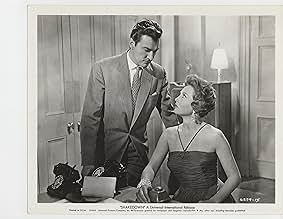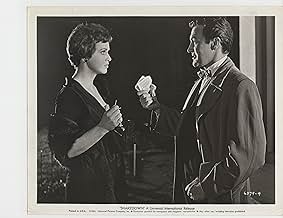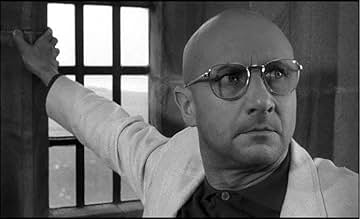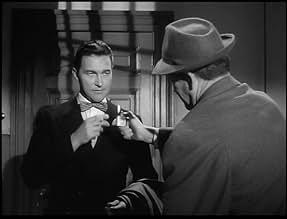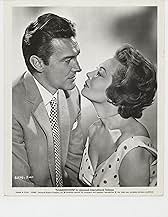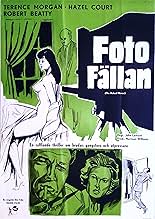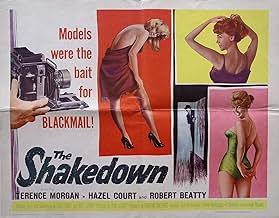Ajouter une intrigue dans votre langueA former pimp, released from prison, disregards his ex-cellmate's advice and reverts to criminal activities, this time involving a photographic model racket.A former pimp, released from prison, disregards his ex-cellmate's advice and reverts to criminal activities, this time involving a photographic model racket.A former pimp, released from prison, disregards his ex-cellmate's advice and reverts to criminal activities, this time involving a photographic model racket.
- Réalisation
- Scénario
- Casting principal
Larry Taylor
- 2nd Thug
- (as Laurence Taylor)
Avis à la une
So far nobody has commented on the truly hilarious title song which is sung in a club scene and over the credits at the end.Films of that era used to like to have a title song as a tie in.The lyrics of this are brief but memorable.The poor songwriter could only come up with "slakedown" and "askdown" as rhymes for shakedown.it has to be heard to be believed.The film itself is a very enjoyable example of a British 1950s gangster film.Mind you poor old Harry H Corbett doesn't look as if he could kill Sooty let alone Terence Morgan.His accent varies tremendously starting off as mid Atlantic.Donald Pleasance gives an inspired performance as a seedy photographer.However as to the blackmail racket,would it have been possible to blackmail someone for taking photos of a nude model.After all married men went to the still open Windmill Theatre and nobody blackmailed them.A bit quaint really,however a very entertaining film nonetheless.Plaudits to distributor Renknown for such a fine print.
Fascinating & slightly risqué B-pic with a good edge to it,Augie Cortona(Terrace Morgan) is release from prison & sets about reclaiming his underworld business from his former henchmen & colleague Gollar(Harry H Corbett) who's taken control of his protection & prostitution racket & left Augie out in the cold until he bumps into out of work photographer Jessup Brown(Donald Pleasance).The two of them Set up in business as a high class agency which is a front for Augie's blackmailing activities in which Jessup get caught up in the corruption which leads him to drink,one is not what she appears to be & Augie soon becomes attractive to her & along with Augie's sidekick Spettigue, Gollar is sorted out with beatings being dispatched & life's fine for Augie. With nightclubs & small racketeers the police are hot on his heels, this film hit the spot well,with pretty Hazel Court.
Clunkily made, but score and acting are good. And the set is decorated by a bevy of would-be models. Augie comes out of prison and finds his old vice racket has been taken over by the sinister Harry H Corbett (Gollar). So he dreams up a new scam, thanks to Donald Pleasance's out of work photographer he meets down the pub. Pleasance (Jessel) provides the business front by taking snaps and running a model school. Meanwhile Augie uses the premises for blackmail. Little does he know that the most beauticious of the girls is an undercover cop. Aaaaah, Britain could really do gangster movies in those days.
Terence Morgan is released from prison. He can't go back to running street walkers; that racket has been taken over by another hood. He meets up with down-on-his-luck photographer Donald Pleasence and decides on a new racket, which he finishes by hitting the guy who took over his racket. On the surface, it's a fashion photography studio run by Pleasence, with a modeling agency and school; the real money is from letting people take 'art studies' of nude women.... and blackmailing them. It's nice while it lasts, but how long before the cops and underworld take notice?
Morgan is pretty good as the tough man with a few soft spots, including Pleasance and modeling student Hazel Court. It's an interesting mix of crime and character study. Philip Green's jazz score Is pretty good, but it becomes repetitious, particularly when it's woven into a nightclub score.
Morgan is pretty good as the tough man with a few soft spots, including Pleasance and modeling student Hazel Court. It's an interesting mix of crime and character study. Philip Green's jazz score Is pretty good, but it becomes repetitious, particularly when it's woven into a nightclub score.
As well as being an entertaining picture, this is a realistic examination of crime and criminals. The descent of the photographer, essentially a decent enough man, into crime, and his staying with it even when offered an out, is very well handled.
We see there are three main things keeping crime in check. The police of course, but also pushing victims until they crack and are no longer rational and predictable, and rivalries among the insanely greedy and self-centered people we call criminals.
My TV guide gave this a very lukewarm review and I nearly didn't bother with it, but I'm glad I did.
We see there are three main things keeping crime in check. The police of course, but also pushing victims until they crack and are no longer rational and predictable, and rivalries among the insanely greedy and self-centered people we call criminals.
My TV guide gave this a very lukewarm review and I nearly didn't bother with it, but I'm glad I did.
Le saviez-vous
- AnecdotesJackie Collins was so tired of being referred to as "Joan Collins sister" that she used the name "Lynn Curtis" for this movie.
- ConnexionsReferenced in Piccadilly Third Stop (1960)
Meilleurs choix
Connectez-vous pour évaluer et suivre la liste de favoris afin de recevoir des recommandations personnalisées
Détails
- Date de sortie
- Pays d’origine
- Langue
- Aussi connu sous le nom de
- The Shakedown
- Lieux de tournage
- Alliance Film Studios, St Margarets, Twickenham, Middlesex, Angleterre, Royaume-Uni(studio: made at Twickenham Studios, London, England.)
- Sociétés de production
- Voir plus de crédits d'entreprise sur IMDbPro
- Durée
- 1h 32min(92 min)
- Couleur
Contribuer à cette page
Suggérer une modification ou ajouter du contenu manquant

